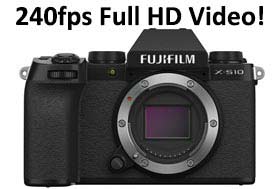The recently released camera called the Fujifilm X-E4 shares many of the traits of their lower brethren but also from the higher-end models in a compact package. It ditches the better viewfinder for a small 2.36 million dot EVF that makes it a bit hard to see your composition but that also allows the camera to be smaller and more stylish than the beefy SLR style Fujis out there.
The Fujifilm X-E4 Slow Motion feature is the same as found on cameras like the excellent Fujifilm XS-10 which is a 120fps or 240fps full HD component that records in camera. Why are we not excited? well, the quality is lower than expected with some aliasing and moire characteristics that are so last decade. When are manufacturers going to offer the same 1080p quality at all frame rates instead of relegating the 120fps and 240fps modes to the lower bitrate and detail bin? → Continue Reading Full Post ←
Now that the surprise camera of 2020 has been out for a while, it is time to revisit the 240fps mode included in the video features. At first glance, it delivered 720p quality or less in an upscaled 1080p wrapper. However many Fuji fans asked us to revisit the slow motion quality of this camera as early samples supposedly did not do justice to what this mode was able to deliver.
We have to agree to some extent that the quality of this camera in 240fps Full HD slow motion is better than other even more expensive options but we still feel that Fuji cut corners when it comes to image quality here by dropping lines and having a pretty noisy output unless there is an ample amount of light. We have some samples that will let you see what this camera is capable of and make you decide if it is a good enough option for your camera collection. → Continue Reading Full Post ←
Two very different new cameras were released this week that are able to shoot in 240fps Full HD 1080p. One is the Fujifilm X-S10 which is an all-rounder mirrorless camera with 6 stop IBIS and cinema video profiles for $999 body only, the other is the sequel to the very well received DJI Osmo Pocket now named DJI Pocket 2 dropping the OSMO part of the name & starting at $349 in its most basic form. Slow Motion on DJI Pocket 2 & Fuji X-S10 is close on both.
Both cameras are able to do 120fps as well but the interest peaks at 240p where the speed makes things moving slower more detailed, especially people as at that speed lifeforms moving relatively slow are excellent subjects. For faster animals like birds or flying insects, you need many more frames per second, usually in the 700+ range to create a good enough effect. → Continue Reading Full Post ←
Fujifilm continues to further evolve their high-end mirrorless offerings by releasing the X-T3 which is a souped-up X-T2 with much of what was missing like 4k 60p and a new X-Trans Sensor now with 2 more megapixels and lower base ISO of 160. The new camera also has a touchscreen with the ability to use up to 425 Phase and Contrast hybrid Autofocus points which is their most advanced AF yet.
Others will point out to the new blackout-free burst shooting much like that in the Sony high end a9 for example. What is really remarkable here is that the 4k 60p mode is 10 bit 4:2:0 vs 8 bit on competitors, as to what big advantage that will be remains to be seen considering 4:2:0 is not exactly ideal. For slow motion fans, the camera now records 120fps 1080p at 200Mbps bs 100Mbps on the X-T2 → Continue Reading Full Post ←
The Fuji X-H1 just announced does a lot of things right; It has a 200mbps 4k codec in UHD / DCI, 120fps Full HD which from the initial looks of it looks gorgeous and it finally has the 5-Axis Stabilizer on the sensor 5.5 stops worth that had eluded Fuji cameras for two years now. It even has a new Eterna color profile which makes it easy to color correct without being too flat or too processed.
However, the X-H1 is based on the same 24MP X-Trans APS-C sensor found on the X-T2 which while overall good, it has problems with color moire and fine textures due to the processing on the unconventional RGB pattern which has 4 adjacent green pixels and differs quite a lot from Bayer sensors. See this article from PetaPixel comparing both technologies here. But as far as video mode is concerned it looks to be a good contender to options like the GH5 and Sony 7 series. → Continue Reading Full Post ←
The Latest on Hi Speed Affordable Imaging!





